For centuries, the mighty Mississippi River has flowed as a lifeline through America’s heartland, sustaining industries, ecosystems, and communities alike. But an unprecedented drought has recently caused its waters to recede dramatically, exposing vast stretches of previously submerged riverbed. As the waters withdrew, they unveiled alarming environmental secrets—long-hidden remnants that nobody anticipated. From hazardous waste to disturbing ecological damage, these discoveries have not only shocked scientists but also raised urgent questions about the river’s future. The Mississippi’s retreat has become both a stark symbol of climate instability and a dire warning, suggesting far graver consequences ahead.
1. Sunken Boats and Shipwrecks
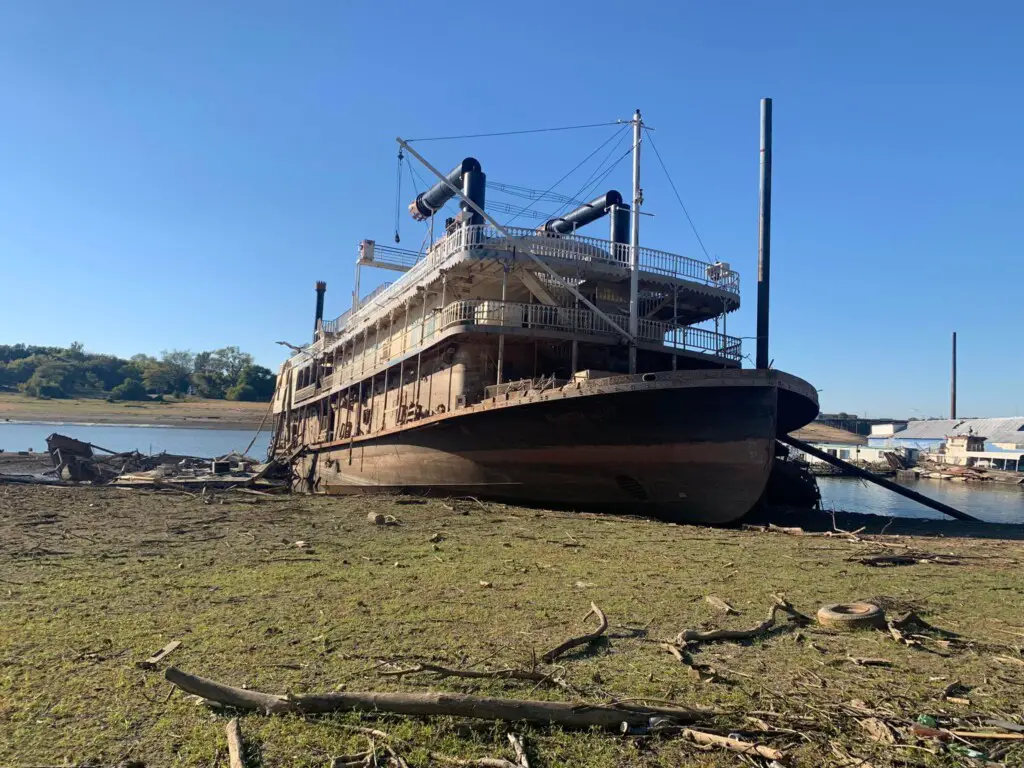
When the Mississippi River dried up to record-low levels in 2022, it revealed something amazing in McKellar Lake near Memphis: the wreck of an old casino boat called the Diamond Lady that used to be completely underwater. The whole boat was now sitting in the mud, completely exposed, which was pretty incredible to see. This wasn’t just any old boat either—the Diamond Lady was actually the first legal gambling boat in America since the 1800s, launched back in 1991 with Vanna White from “Wheel of Fortune” cutting the ribbon. The boat had been parked in the lake since 2008, but it sank during a really bad winter freeze in 2021 and stayed underwater until the big drought in 2022 basically drained the lake enough to expose it. People could actually walk right up to the rusty old boat and look inside the rooms where people used to gamble, though now they were just filled with mud. It was like stepping back in time to see this piece of gambling history that had been hidden underwater for over a year.
2. Toxic Waste Barrels

Perhaps most alarming were the countless barrels of hazardous waste that surfaced from beneath the drying Mississippi River. Rusted containers, corroded by decades underwater, were now exposed—many leaking unknown chemicals into the soil. Preliminary investigations suggest industrial origins, with some barrels traced back to factories and disposal sites dating as far as the mid-20th century. Environmental experts warn that these chemicals, including carcinogenic compounds and heavy metals, pose immediate threats to wildlife, contaminating water supplies and disrupting delicate ecosystems. The appearance of these barrels underscores a troubling legacy of irresponsible waste management, now starkly visible due to the drought.
3. Abandoned Vehicles

Alongside barrels and shipwrecks, the receding waters revealed a surprising number of abandoned vehicles scattered along the riverbed. Dozens of rusting cars and trucks, their paint faded and metal structures corroded, emerged like eerie artifacts from beneath the mud. Authorities speculate many were deliberately discarded decades ago, while others likely entered the river through floods or accidents. These vehicles carry significant environmental risks, as leaking oil, gasoline, antifreeze, and battery acids threaten nearby wildlife and communities dependent on river resources. The unexpected presence of these submerged automobiles highlights a troubling disregard for the environment, now vividly exposed by the drought.
4. Human Remains

Perhaps the most unsettling discoveries along the drying Mississippi River were the human remains emerging from the mud and sediment. A woman looking for rocks along the banks of the drought-stricken Mississippi River discovered bones that turned out to be human. The remains include a lower jawbone, rib bones and some unidentified bone pieces, according to Coahoma County, Mississippi, Chief Medical Examiner Scotty Meredith. Crystal Foster found the remains while searching for rocks with her family, telling local news “We know we found a rib bone. We found a lower mandible, a jawbone with teeth in it.” The bones were sent to the state crime lab for DNA analysis to compare with missing persons cases.
5. Unexploded Ordnance

Adding to the alarming revelations, receding waters exposed several cases of unexploded military ordnance scattered along the Mississippi riverbed. Rusting artillery shells, grenades, and ammunition—relics from past military exercises and historical conflicts—surfaced, prompting urgent safety concerns. Authorities swiftly dispatched bomb disposal teams and explosive ordnance experts to safely remove and dispose of these dangerous artifacts. However, the presence of these explosives highlights an overlooked environmental and public safety risk, as unstable ordnance can pose lethal hazards to residents, wildlife, and cleanup crews alike. These discoveries underline the ongoing need for careful monitoring and comprehensive assessments along previously submerged riverbanks.
6. Lost Historical Artifacts

Amid the unsettling revelations, receding waters also unveiled remarkable historical artifacts, offering rare glimpses into the past. Archaeologists and historians discovered ancient pottery fragments, tools, and personal belongings dating back centuries, each artifact providing valuable insights into the daily lives of early indigenous communities and settlers along the river. Experts emphasize the immense cultural significance of these finds, launching coordinated preservation efforts to safeguard them from environmental deterioration and looters. Yet, despite these efforts, specialists worry the rapid exposure and subsequent erosion could irreversibly damage fragile items, underscoring the urgent need to document and protect this newfound historical heritage.
7. Industrial Waste Sites

The drying Mississippi has also revealed unsettling evidence of previously submerged industrial waste sites, long hidden beneath its waters. Exposed industrial dumps now dot the riverbed, contaminated with heavy metals, petroleum byproducts, and persistent chemical pollutants. Environmentalists express grave concerns over these toxins leaching into groundwater, endangering local wildlife habitats and potentially threatening public health through contaminated drinking water supplies. Authorities have initiated emergency cleanup operations, deploying environmental specialists to assess contamination levels and mitigate immediate risks. Still, these newly uncovered waste sites highlight a troubling legacy of industrial negligence, urgently requiring comprehensive strategies to prevent further environmental damage.
8. Agricultural Runoff Deposits
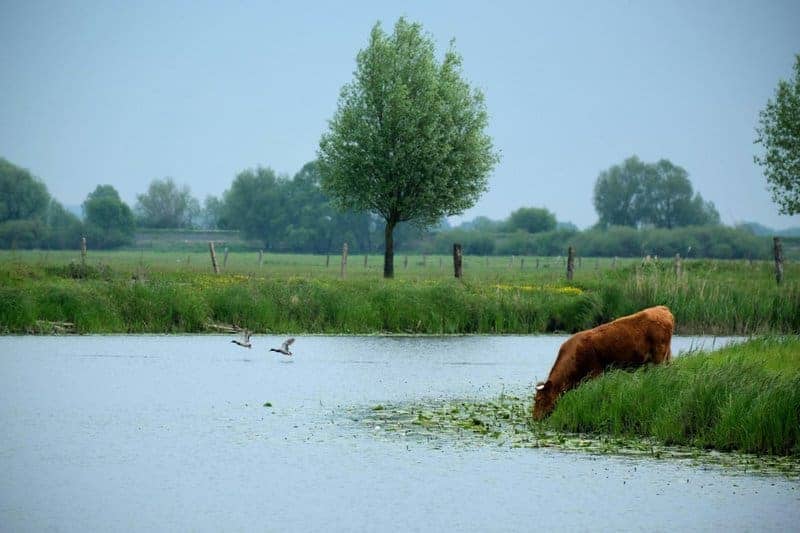
The receding waters have also exposed troubling deposits of agricultural runoff along the Mississippi’s dwindling shores. Thick layers of sediment laced with fertilizers, pesticides, and livestock waste now visibly coat vast stretches of the riverbed. Environmentalists warn these nutrient-rich pollutants fuel the growth of toxic algae blooms and dangerously impact local ecosystems, choking aquatic life and contaminating water sources relied upon by communities downstream. Researchers are especially concerned about the concentration of nitrates and phosphates, chemicals known to pose significant health risks to humans and wildlife alike—highlighting the urgent need for improved farming practices and robust environmental safeguards.
9. Invasive Species Expansion

The Mississippi’s declining water levels have inadvertently provided ideal conditions for invasive species to spread rapidly, profoundly altering local ecosystems. Non-native plants such as hydrilla and Eurasian watermilfoil have thrived in the shallow, stagnant waters, crowding out native vegetation essential for wildlife. Simultaneously, invasive fish like Asian carp have exploited the changing habitats, quickly outcompeting native species for limited resources. Biologists warn this sudden expansion threatens to permanently disrupt biodiversity, placing native species at risk of extinction. The drought has thus accelerated an ecological crisis, highlighting the urgent need for strategic intervention to restore balance and protect native habitats.
10. Decaying Infrastructure

The drought has also exposed alarming deterioration in critical infrastructure along the Mississippi’s banks. Aging dams, bridges, and levees—previously concealed beneath the river’s surface—now visibly reveal deep cracks, rusted supports, and significant structural erosion. Engineers inspecting these sites warn that such compromised infrastructure poses substantial risk to nearby communities, potentially leading to catastrophic failures during future floods or storms. Authorities have initiated urgent inspections and emergency repairs, yet the scale of decay underscores decades of neglect and inadequate maintenance. These discoveries highlight the pressing need for renewed investment and proactive measures to protect communities increasingly vulnerable to climate extremes.
11. Animal Remains and Mass Death Events

As the Mississippi’s water levels dropped, disturbing scenes of animal remains and mass die-off events emerged along exposed riverbanks. Researchers documented numerous carcasses of fish, birds, turtles, and mammals, suggesting significant ecological disruptions beneath the river’s surface. Preliminary investigations attribute these deaths to a combination of oxygen depletion, toxin exposure from pollutants, and habitat loss caused by changing water conditions. Ecologists express serious concerns about declining biodiversity and potential long-term ecosystem collapse. These tragic events illustrate how rapidly shifting environmental conditions, intensified by drought, can devastate wildlife populations—underscoring the urgent need to address underlying ecological issues along the river.
12. Illegal Dump Sites
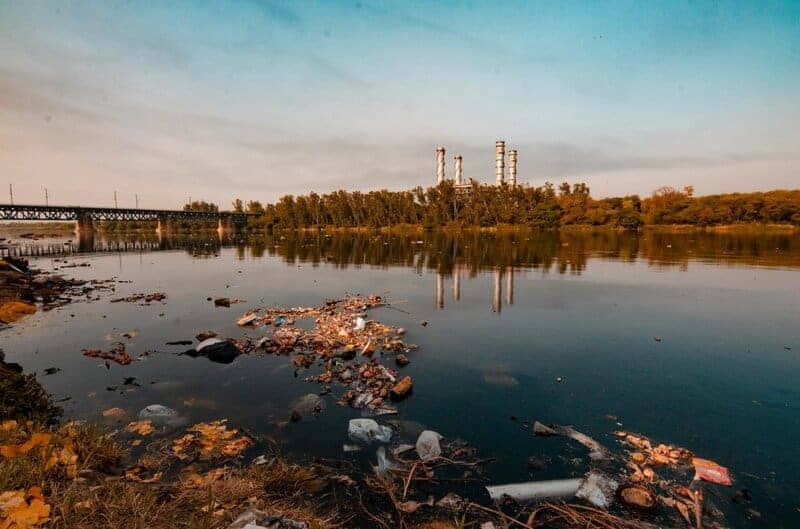
The receding Mississippi waters have also laid bare numerous illegal dump sites, previously hidden beneath the river’s surface. Authorities discovered piles of discarded appliances, construction debris, tires, household garbage, and even hazardous materials deliberately dumped along secluded stretches of the riverbank. These illicit sites pose significant environmental threats, contaminating soil and groundwater with chemicals, heavy metals, and toxic substances. Environmental experts warn that the pollutants from these dumpsites endanger wildlife habitats and threaten local communities relying on clean water resources. The exposure of these illegal sites emphasizes the critical need for stricter enforcement and community awareness to combat irresponsible waste disposal practices.
13. Petroleum and Chemical Spills
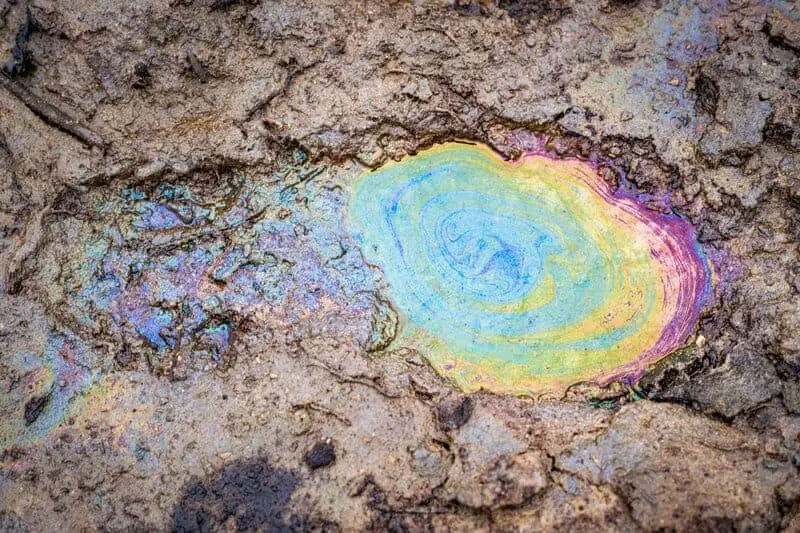
The drought’s relentless grip has unveiled troubling evidence of petroleum and chemical spills previously concealed beneath the Mississippi’s waters. Dark stains of crude oil, slick residues, and vividly discolored sediments now mark the dried riverbed, indicating long-hidden leaks from pipelines, storage tanks, and industrial facilities. Environmental specialists warn these spills threaten delicate ecosystems, poisoning wildlife habitats and contaminating vital water resources used by nearby communities. Cleanup crews have mobilized swiftly to contain and remediate affected areas, employing absorbent barriers, bioremediation techniques, and chemical neutralizers. Yet, these discoveries underscore the need for stronger oversight and improved infrastructure to prevent future environmental disasters.
14. Lost Towns and Settlements

The receding Mississippi River has remarkably uncovered forgotten towns and settlements, long submerged beneath its murky depths. Decades ago, communities such as Kaskaskia and Napoleon vanished underwater due to flooding, river rerouting, and deliberate inundation during infrastructure projects. Now eerily visible again, their crumbling foundations, streets, and decaying buildings serve as poignant reminders of past livelihoods and lost histories. Archaeologists and historians eagerly seize this rare opportunity to document and study these ghost towns before erosion and further environmental exposure erase their traces permanently. Yet, these reemerging settlements also highlight the powerful, unpredictable nature of the river and its enduring influence over human communities.
15. Garbage Accumulation

The Mississippi’s shrinking waters have revealed extensive accumulations of garbage, previously hidden beneath its surface. Plastic debris, discarded packaging, single-use items, and other refuse now visibly litter vast stretches of exposed riverbed, posing profound threats to wildlife and aquatic ecosystems. Environmentalists have noted wildlife entanglement, ingestion of plastic fragments, and the contamination of food chains as immediate concerns. Community groups and conservation organizations have swiftly mobilized cleanup initiatives, organizing volunteers to remove tons of waste. Yet, the scale of garbage uncovered underscores a deeper, systemic issue—highlighting an urgent need for improved waste management policies and greater public awareness about environmental stewardship.
16. Ancient Fossils
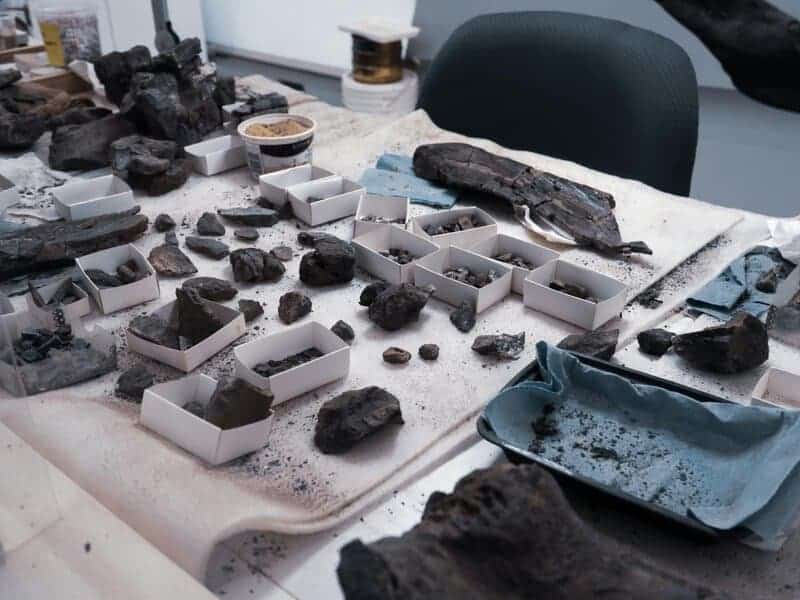
Remarkably, the receding waters of the Mississippi have also unveiled an unexpected scientific treasure trove: ancient fossils dating back millions of years. Paleontologists have discovered fossilized remains of prehistoric marine creatures, including shark teeth, mollusk shells, and even fragments from long-extinct reptiles. These remarkable finds offer invaluable insights into Earth’s distant past and the region’s geological history, sparking new research efforts to understand ancient ecosystems and climate conditions. Scientists are urgently working to document and preserve these delicate specimens before erosion or human interference causes irreversible damage. The unexpected fossil discoveries underscore the Mississippi’s significance as a living record of natural history.
17. Old Cemetery Sites
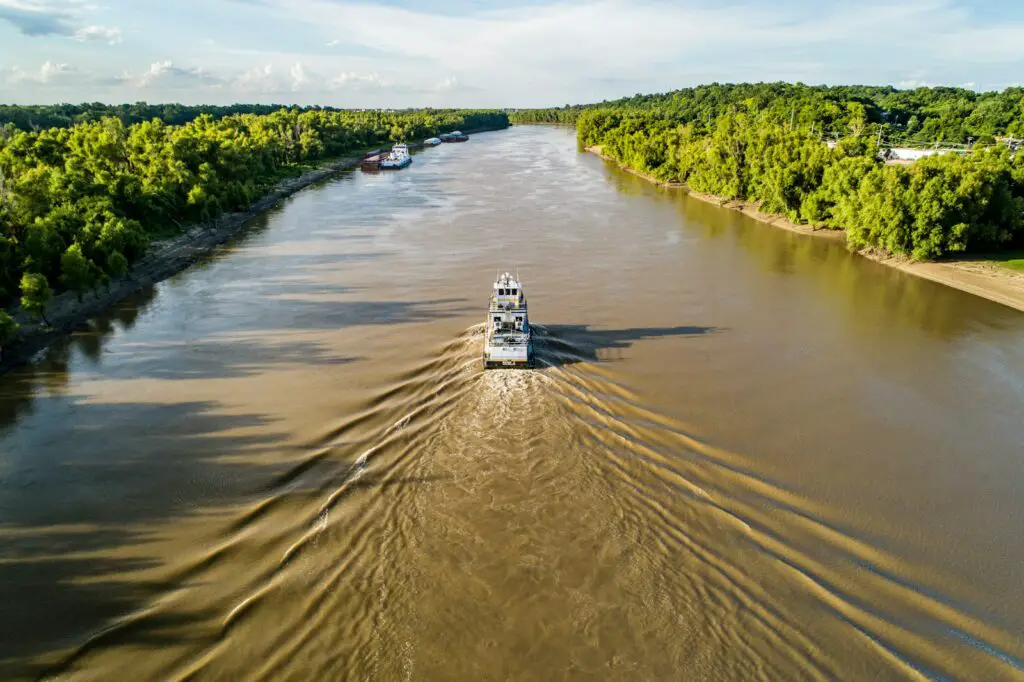
As the Mississippi’s waters retreated, several submerged cemetery sites—some dating back centuries—have resurfaced, revealing gravestones, memorial markers, and even exposed burial plots. These forgotten burial grounds carry profound historical significance, offering glimpses into past communities and their cultural practices. Historians and archaeologists have approached these sites cautiously, balancing the importance of historical documentation with ethical respect for the deceased and their descendants. Meanwhile, local authorities grapple with sensitive decisions regarding preservation, reinterment, and public accessibility. Such discoveries compel communities to confront past practices of flooding land for infrastructure projects, raising important ethical questions about honoring and protecting ancestral resting places.
18. Depleted Aquatic Ecosystems

The prolonged drought has inflicted catastrophic damage on the Mississippi River’s aquatic ecosystems, leaving behind devastated habitats and widespread fish die-offs. Shallow waters and rising temperatures have drastically reduced oxygen levels, creating lethal conditions for countless aquatic species. Fish populations have plummeted, with conservationists reporting mass mortality events affecting native species crucial for maintaining ecological balance. Additionally, declining water levels have disrupted breeding grounds and migratory pathways, placing further stress on vulnerable wildlife. Ecologists warn that without immediate intervention and habitat restoration, irreversible biodiversity loss could occur—altering the river’s ecological dynamics and impacting communities dependent on its resources.
19. Submerged Railways and Roads

The Mississippi’s dramatic retreat has uncovered forgotten railways and roadways, once vital transportation arteries submerged for decades. Rusting railroad tracks, decayed wooden ties, and crumbling asphalt roads now stretch eerily across exposed riverbeds, tangible reminders of historic routes abandoned due to flooding or infrastructure changes. Historians and engineers alike have seized the opportunity to document these rediscovered networks, shedding new light on regional development and economic history. However, the deteriorating condition of these relics presents environmental challenges, as corrosion and decayed materials risk contaminating nearby habitats. Authorities are carefully assessing these sites, balancing preservation efforts with necessary safety precautions.
20. Erosion and Sediment Issues
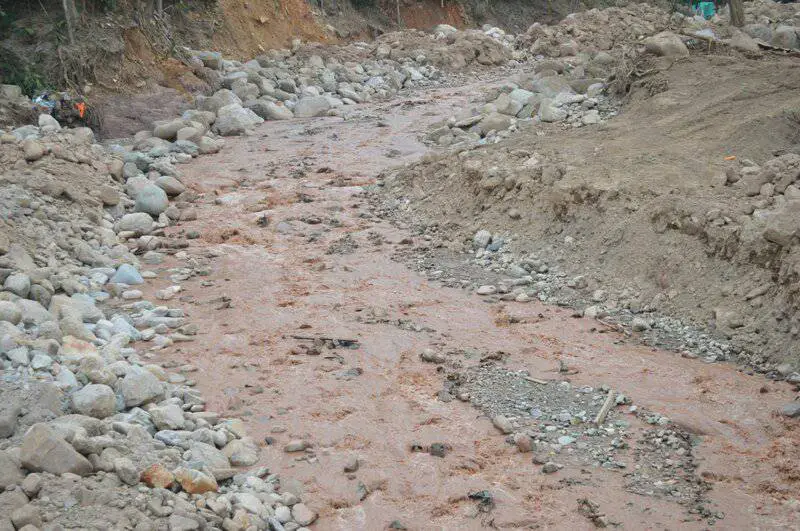
The retreating waters of the Mississippi have starkly revealed severe erosion and sediment accumulation issues, previously hidden beneath its currents. Exposed riverbanks now display extensive erosion scars, unstable slopes, and sediment buildups blocking vital channels. Experts warn that unchecked erosion threatens water quality, increases flood risks, and further endangers aquatic habitats already under stress. Sediment deposits have altered river flows, complicating navigation and impacting ecosystems downstream. Scientists and policymakers are exploring targeted solutions, including shoreline stabilization, planting native vegetation, and sediment management strategies, to mitigate these threats. Addressing these erosion problems is essential to protect the river’s long-term ecological and economic viability.
Wrap-up
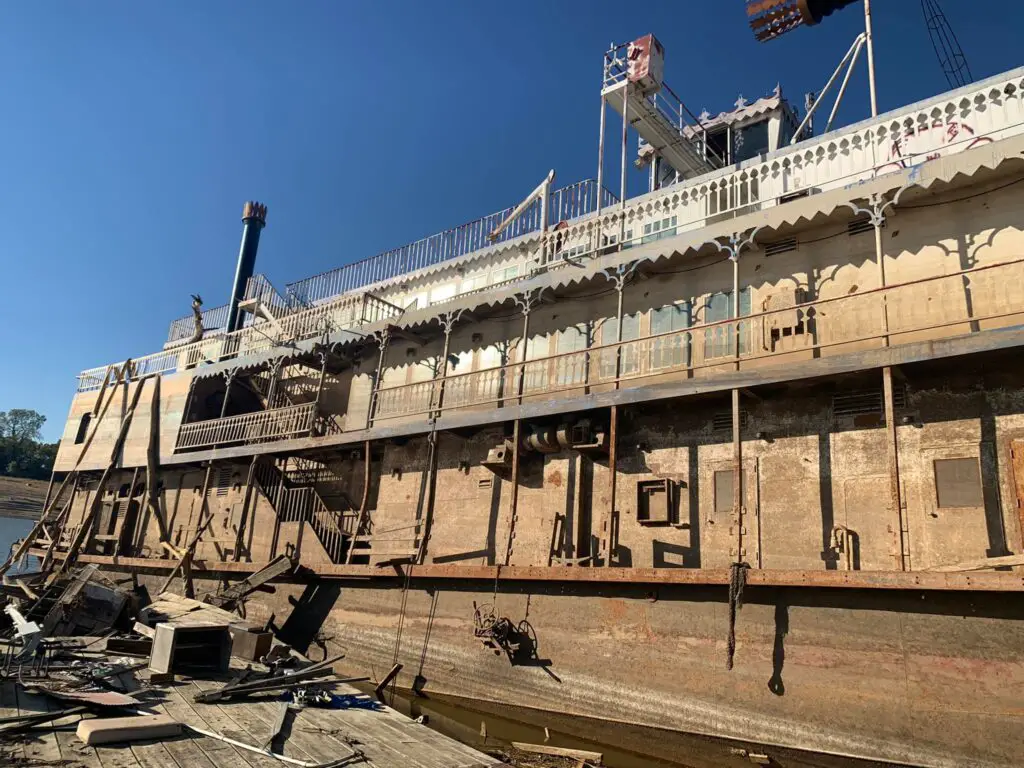
The Mississippi River’s unprecedented drought has vividly exposed an ecological crisis long hidden beneath its surface. From hazardous industrial waste and toxic pollutants to lost historical settlements and severely damaged ecosystems, these revelations demand immediate attention and action. They serve as a stark reminder of the consequences of environmental neglect and unsustainable practices. It is imperative for communities, policymakers, and individuals alike to prioritize ecological preservation, invest in sustainable infrastructure, and take decisive climate action. Only through collective responsibility and proactive measures can we safeguard the Mississippi’s future, ensuring that such environmental horrors remain lessons learned rather than repeated tragedies.

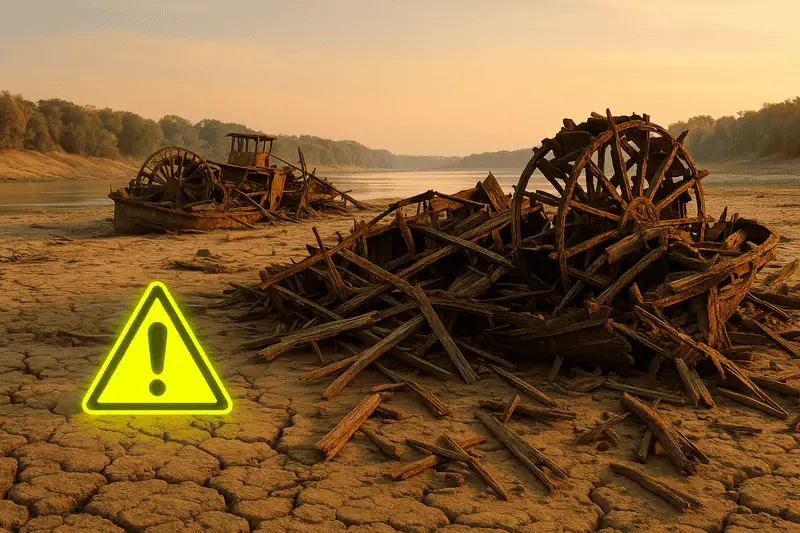

Vielleicht interessiert es Sie:
Wussten Sie! Minensuchratten auf dem Schlachtfeld und sie sind super effektiv!
Wie viele Giraffenarten gibt es? Leben sie alle in Afrika?
Der Vogel ist das Weibchen der Vögel: wahr oder falsch?
Warum bauen Biber Dämme? Welchen Nutzen?
Warum leben manche Tiere nachtaktiv? Welche Vorteile?
Küssen Tiere? Ist das die gleiche Bedeutung wie Menschen?
200+ Hilarious Seahorse Jokes That Will Make You Smile and Giggle
200+ Funny Investment Jokes to Boost Your Financial Humor Game